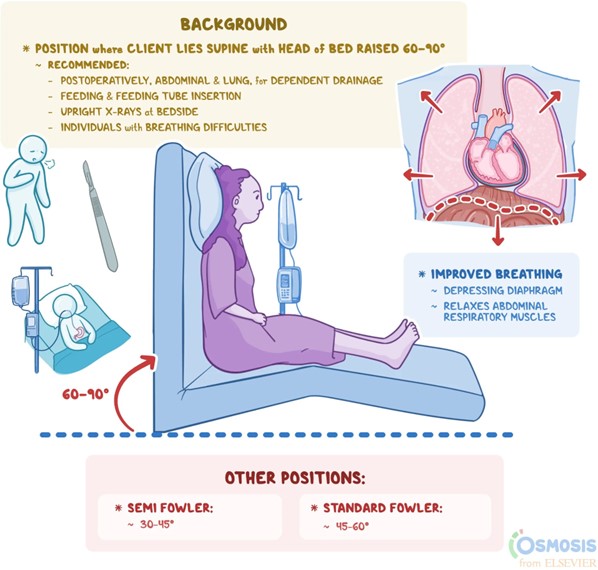A nurse is contributing to the plan of care for a client who has urinary incontinence.
Which of the following interventions should the nurse include in the plan?
Keep the head of the client's bed elevated to 45".
Limit periods of sitting in a chair to 4 hr.
Use a no-rinse perineal cleanser after incontinence.
Avoid the use of draw sheets for repositioning.
The Correct Answer is C
Urinary incontinence is the involuntary loss of urine, and it can have various causes and contributing factors. When developing a plan of care for a client with urinary incontinence, it is important to address interventions that promote comfort, hygiene, and prevention of complications.
using a no-rinse perineal cleanser after incontinence, is an appropriate intervention for maintaining skin hygiene and preventing skin breakdown. Cleansing the perineal area after episodes of urinary incontinence helps to remove any urine residue and reduce the risk of skin irritation or infection. No-rinse cleansers are often preferred as they are gentle on the skin and do not require rinsing, which can be more convenient for the client.
keeping the head of the client's bed elevated to 45 degrees in (option A) is incorrect because it, is not directly related to managing urinary incontinence. This intervention is typically used for clients at risk for aspiration or to improve respiratory function.
limiting periods of sitting in a chair to 4 hours in (option B) is incorrect because it, may be beneficial to prevent prolonged pressure on the pelvic floor muscles and promote circulation. However, it does not specifically address managing urinary incontinence.
avoiding the use of draw sheets for repositioning in (option D) is incorrect because it, is not directly related to managing urinary incontinence. Draw sheets are commonly used to assist with repositioning and transferring clients.
Nursing Test Bank
Naxlex Comprehensive Predictor Exams
Related Questions
Correct Answer is C
Explanation
During an external chemical disaster, it is crucial to minimize the exposure of clients to hazardous substances. Moving clients to a room above ground level with few windows can help reduce the risk of exposure to the chemical and its fumes. This is because many hazardous chemicals tend to be denser than air and may settle closer to the ground. Choosing a room above ground level and with fewer windows can provide a safer environment.
Turning on fans in the facility to circulate air can actually worsen the situation by spreading the chemical and its fumes throughout the facility, potentially exposing more individuals.
Covering the electrical outlets with wet towels is not directly related to preparing for an external chemical disaster. It may be more relevant during a fire emergency to prevent the spread of flames, but not for chemical exposure.
Opening the fireplace dampers in the day room can allow the entry of outside air and potentially introduce more of the hazardous substance into the facility.
Correct Answer is D
Explanation
The client's crackles in the bases of the lungs and an increased respiratory rate indicate the presence of fluid accumulation in the lungs, which is commonly seen in clients with heart failure. Maintaining the client in a high Fowler's position helps to promote optimal lung expansion and ventilation by reducing the pressure on the diaphragm, allowing for improved breathing mechanics and enhanced oxygenation.

Increasing the client's intake of oral fluids: While maintaining hydration is generally important, increasing oral fluids may not directly address the issue of fluid accumulation in the lungs. The priority in this situation is to optimize the client's respiratory function.
Instructing the client to cough every 4 hours: Coughing alone may not be sufficient to resolve the fluid accumulation. The underlying cause of the crackles and increased respiratory rate in heart failure is fluid congestion, which requires more comprehensive management.
Encouraging the client to ambulate to loosen secretions: While ambulation is generally beneficial for clients with heart failure, it may not directly address the fluid accumulation in the lungs. Ambulation can help improve overall cardiovascular function and fluid balance, but in the presence of acute respiratory distress or significant fluid overload, the client may not be able to tolerate or benefit from ambulation immediately.
In addition to maintaining the client in a high-Fowler's position, the nurse should also collaborate with the healthcare provider to initiate appropriate interventions, such as administering diuretic medications to help remove excess fluid and improve respiratory status. Monitoring the client's oxygen saturation, providing supplemental oxygen as needed, and assessing other vital signs are also important aspects of care in managing heart failure-related respiratory symptoms.
Whether you are a student looking to ace your exams or a practicing nurse seeking to enhance your expertise , our nursing education contents will empower you with the confidence and competence to make a difference in the lives of patients and become a respected leader in the healthcare field.
Visit Naxlex, invest in your future and unlock endless possibilities with our unparalleled nursing education contents today
Report Wrong Answer on the Current Question
Do you disagree with the answer? If yes, what is your expected answer? Explain.
Kindly be descriptive with the issue you are facing.
